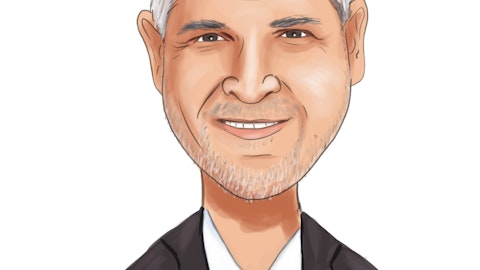Peter Smith: Here’s what I could say. We don’t have the funnel broken down right in front of us. But what I can say is the first year, what we did was we stabilized the business. We took out the Canadian public listing cost, so — and that went better than expected. And year two of their ownership we’re starting to recognize cross-selling opportunities, right? So selling Aviat product to Redline customers and vice versa. And then thirdly, in the last 90 days, we announced — or approximately 90 days, we announced putting our network management software on the Redline products, which we think over the next six months, we’ll start to land some of those and we’ll drive some additional margin expansion.
Jaeson Schmidt: Okay. That’s helpful. And then just as a follow-up, how big of a contributor was the Aviat store in fiscal ’23 or just Q4?
Peter Smith: In the fiscal year, it was about 8% to 9%, pretty similar to contributor as last year.
Jaeson Schmidt: Okay, perfect. Thanks a lot guys.
Operator: One moment for our next question. And our next question will come from the line of Theodore O’Neill from Litchfield Hills Research.
Theodore O’Neill: Thank you very much and congratulations on the good quarter, Peter.
Peter Smith: Thanks, Theodore.
Theodore O’Neill: First question on guidance. If I take the midpoint of the range of guidance for sales and EBITDA, it implies EBITDA grows twice as fast as revenue. What’s the driver for that?
Peter Smith: Yes. So look, we’ve had an emphasis on profitable growth since I arrived here, and that’s what we’re continuing to do. We think a favorable mix driven by North America private networks adding more software into the mix and we get leverage out of our increase in volume. And that — all of that doubling on the midpoint of profitability versus top line growth is also while we plan to invest in R&D. So I think that our plan is to execute that and I really think that’s an insightful question. Theo, thanks.
Theodore O’Neill: Okay. On the BEAD state allocations, I’ve read that New Mexico and Minnesota are saying that if they do an all allocation to fiber, they’re not going to reach the goals of getting everyone on to broadband. Does that create an opportunity for microwave? And also if it does, is there some selling effort that needs to go on to make that happen?
Peter Smith: Okay. So let me talk about the selling effort first. The reason Aviat’s excited, but it’s early days for — it’s a little bit premature for BEAD is Aviat’s best relationships out of all of our customers are with state governments. And that’s due to our 911 first responder private network business. So that — so we are really excited about what Minnesota and New Mexico and the seven congressional representatives that we cited at. So we think that this is a — BEAD is a great opportunity for us albeit a little bit out in time. And then the comments on fiber being too expensive, it is. There was a — there was a congressional rep from Kentucky basically said, are we going to really run fiber to seven homes. So — and what Minnesota and New Mexico said is that fiber is too expensive.
And certainly, to connect low-density end points, it doesn’t make sense. So we see that this as an opportunity. We see states starting to say they’ll get more mileage for their money using wireless and we’re starting to see it in Congress. So we think that this is a fantastic development, and we just need to continue to use our sales channel that carries the 911 private network business. It’s for the same state, the same procurement organization. We think we’re well positioned.
Theodore O’Neill: Okay. My last question is that last week, the FCC granted special authority to AT&T to use microwave backhaul in Maui because the cable network infrastructure was destroyed. Are you seeing any increase in like weather disaster awareness among your clients as a possible sales benefit for use in microwave? Or is this just something that always happens whenever there’s a disaster?
Peter Smith: So this happens typically in disaster, right? So we — so we have network in — on Maui. What we did for the customer when this happened was — so it’s not the AT&T deployment, but it’s the utilities we help monitor their network. We recommended the damage that they had, how they should respond from a networking perspective. We do this when Hurricane’s hit, we did this with the Nashville bombing issue. So here’s one of the thing that I’d like to emphasize. The reason microwave has traction in situations like this is because it’s faster deployed and it’s actually more reliable than fiber.
Theodore O’Neill: Okay. Thank you very much.
Operator: One moment for your next question. And our next question will come from the line of Tim Savageaux from Northland Capital Markets. Your line is ready.
Tim Savageaux: Great. Thanks and congratulations on your third year of double-digit revenue growth. And on the order growth in particular, which looks to be when you start with the two, given the strength in backlog that you reported. And so I’ll kind of ask my annual fiscal year-end question about, well, a couple of things really about that order growth and backlog growth relative to what you’re guiding to from a revenue growth perspective, you’re trying to relate those two items. And then as you look at the fiscal ’23, you’re kind of flattish in the U.S. and big international growth based on the order book or any other visibility you might have, how do you expect that to change into ’24, I guess, given what you’re seeing from a backlog perspective? I’ll follow up on that.
Peter Smith: So with the backlog — the growth in backlog was the principal driver of that was growth in North American private networks, right? So ’23 was flattish in North America, and we see North America, the demand environment picking up. So we’ll get a bigger contribution from North America than we did in ’23. We also think that, that favors margin growth. And then in terms of how to think about the backlog and trying to roll out a couple of sentences around the guidance. We did — in the recently completed quarter, we did see some big projects come in, the statement about wanting to look at how the customers’ projects develop is really related to how fast we get to the design fees and how fast we get that to revenue. And if that — if the customers want to move quickly, then we will, as the year progresses, update our guidance. And if they kind of go at a slower pace then we’ll leave the guidance as is. But we’re hopeful, Tim.





